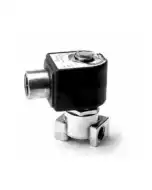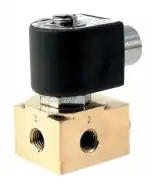Solenoid Valves
Solenoid Valves
02F30C1103AAF
Parker Gold Ring Series 3-Way Normally Closed 1/8" Direct Acting, Brass Pressure Vessel
$143.01 $170.2502F30C1103AAF4C05
Parker Gold Ring Series 3-Way Normally Closed 1/8" Direct Acting, Brass Solenoid Valve, 120/60-110/50 VAC 1/2" Conduit
$177.01 $210.7302F30C1106AAFOS05
Parker Gold Ring 3 Way Normally Closed 1/8" NPT Direct Acting Brass Solenoid Valve 110/50 120/60 VAC Spade
$208.34 $248.0202F30O1103AAF4C05
Parker Gold Ring Series, 3-Way Normally Open, 1/8” NPT Direct Acting Brass, 120/60-110/50 VAC ½” Conduit with 18” Leads
$179.72 $213.9502F30U1104ABF
Parker Gold Ring Solenoid Valve, 3-Way, Universal, Air, Water, Light Oil, 1/8”,100 Psi, 1/16 Inch, 10.2 Watts, Brass, NBR
$138.16 $164.4802F30U1104ABFOS05KMP
Parker Gold Ring Solenoid Valve
$307.20 $365.7204F20C1108AAF4C05
Parker Gold Ring Solenoid Valve, 2-Way Normally Closed, ¼” NPT, Direct Acting Brass, ½” Conduit with 18” Leads, 120/60 VAC
$128.38 $152.8304F20C3318BDF4C01
Parker Gold Ring Fluid Control Solenoid Valve, 2-Way Normally Closed, 303 Stainless Steel, EPDM Seals, ¼”, 90 PSi, ½” Conduit, 24/60 VAC, 16 Watts with 18” Leads
$257.88 $307.00- $113.34 $134.93
04F20O1106ACFR
Parker Gold Ring Repair Kit
$145.01 $172.63- $115.76 $137.81
04F20O2118ACFR
Parker Gold Ring Repair Kit
$126.18 $150.21- $111.94 $133.26
04F25C2122C3F4C75
Parker Gold Ring 2-Way Normally Closed 1/4" Pilot Operated Brass Solenoid Valve, 1/2" NPT Conduit, 12VDC
$179.49 $213.6804F25C2122C3FR
Parker Gold Ring Repair Kit
$80.53 $95.87- $113.95 $135.66
04F25C2122CAFR
Parker Gold Ring Repair Kit
$75.12 $89.43- $125.90 $149.88
04F30C2104ADFEC05
Solenoid Valve, 3-Way Normally Closed, Air, Water, Light Oil, ¼” NPT Brass, 120/60 VAC ½” Conduit
$318.40 $379.0504F30U2106ADF4C05
Parker Skinner 3-Way Universal, 1/4" NPT Direct Acting Brass, Solenoid Valve, 120/60 VAC Conduit with 18" Leads
$176.42 $210.0204F30U3204ABF4C01
Parker Gold Ring Solenoid Valve, 3-Way Universal, ¼” NPT Stainless Steel Body, 24/60 VAC Conduit
$283.75 $337.8004F35C1116ACF4C01
Parker Gold Ring Solenoid Valve, 3-Way, Normally Closed, ¼” NPT Brass Body, 24 VDC, ½” Conduit with 18” Leads
$290.46 $345.78- $256.50 $305.35
04F48S2106ACFR
Parker Gold Ring Repair Kit
$179.80 $214.0506F22C2140A3F
Parker Gold Ring Series 2-Way Normally Closed 3/8" Pilot Operated, Brass Pressure Vessel
$100.88 $120.10- $99.62 $118.59
06F22C2140AAFR
Parker Gold Ring Repair Kit
$126.14 $150.1706F22C2140ADFPH01
Parker Gold Ring/Skinner Solenoid Valve, 2-Way Normally Closed, 3/8” NPT Brass, 24/60 VAC Din Connection
$143.64 $171.00- $115.21 $137.15
06F23C2140ACFR
Parker Gold Ring Repair Kit
$169.44 $201.7206F23C6140ACF4C05
Parker Gold Ring 2-Way Normally Closed 3/8” Stainless Steel Valve, ½” Conduit, 120/60 VAC with 18” Leads
$588.77 $700.9206FS5C2432ACH4C05
Parker Gold Ring Solenoid Valve, 2-Way Normally Closed, Steam, 3/8” NPT, 125 PSi, Brass, ½” Conduit Housing with 18” Leads, 120/60-110/50 VAC
$350.47 $417.23- $150.87 $179.61
08F22C2140A3FR
Parker Gold Ring Repair Kit
$89.97 $107.11- $147.88 $176.05
08F22C2140AAF4C05
Parker Gold Ring Series 2-Way Normally Closed 1/2" Pilot Operated Brass Solenoid Valve, 120/60 VAC 1/2" Conduit with 18" Leads
$205.49 $244.6308F22C2140AAFR
Parker Gold Ring Repair Kit
$126.14 $150.17- $165.67 $197.23
- $163.96 $195.19
08F23C2140ACFR
Parker Gold Ring Repair Kit
$169.44 $201.72- $921.24 $1,096.72
08F23C6140ACFR
Parker Gold Ring Repair Kit
$185.29 $220.58- $360.82 $429.55
08F23O2140A3FR
Parker Gold Ring Repair Kit
$168.53 $200.63- $359.60 $428.09
08F23O2140ACF4C05
Parker Gold Ring 2-Way Normally Open, ½” NPT Brass, Solenoid Valve, 120/60 VAC Conduit Housing, ½” NPT with 18" Leads
$426.84 $508.1408F23O2140ACFR
Parker Gold Ring Repair Kit
$215.39 $256.4208F25C2132ACF
Parker Gold Ring Pressure Vessel 2-Way Internal Pilot Operated, Normally Closed, Brass
$199.20 $237.1408F25C2132ACFPH05
Parker Gold Ring/Skinner Solenoid Valve, 2-Way Normally Closed, ½” NPT Brass, 120/60-110/50 VAC Din Connection
$266.85 $317.6808F25C2132ACFPH15
Parker Gold Ring/Skinner Solenoid Valve, 2-Way Normally Closed, ½” NPT Brass, 240/60-220/50 VAC Din Connection
$266.85 $317.68
New Industry Standards for Reliability
Whether you want general purpose, water, hazardous location, steam, high pressure, cryogenic, or media-separated solenoid valves, we only bring you hydraulic solenoid valves that continuously meet the requirements of the latest standards for quality and reliability.
G&G Hydraulics Corporation is committed to helping you find the complete solenoid valves, accessories, repair kits, and other parts you need to ensure continued operations. Our top-brand hydraulic valves are known for their long life, consistent pressure control, and fast response time.
Compact Design and Superior Durability
Our solenoid valves feature a compact design and superior build durability that ensures efficient and reliable operations for your hydraulic applications. These high-cycle solenoid valves are perfect for automation processes and help reduce your downtime.
Choose from different solenoid valve options like valve functional type, repair kit type, coil type, pressure differential, valve actuation, repair kit seal material, coil voltage, maximum operating pressure differential, body port options, and product lead time. We have all the valve variations you can imagine so you can buy solenoid valves online with total confidence.
Shop Now
G&G Hydraulics Corporation offers a live chat feature if you need help choosing the correct hydraulic parts and accessories for your applications. We’re a certified seller of hydraulic supplies and offer excellent customer service that you can count on every time. Order your hydraulic solenoid valves now and enjoy discounts and a risk-free guarantee.




















































